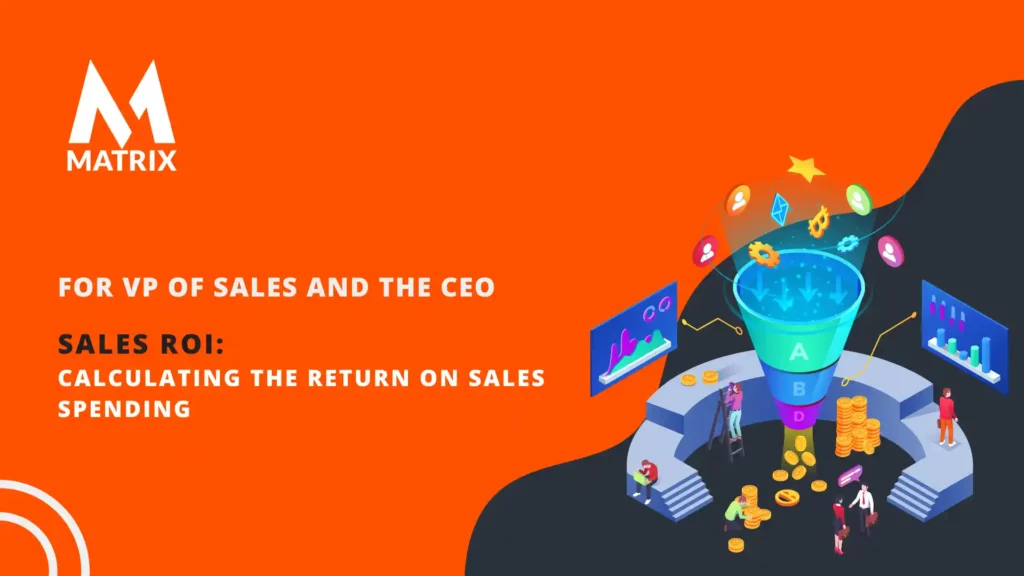Sales ROI: Calculating the Return on Sales Spending
Learn why Sales ROI is vital to profitability and better productivity. See how calculating the return on sales spending is impacted the quality of the leads accepted by sales. Sale is a downstream function in the marketing funnel.
Our marketing funnel is MCL => MQL => SAL => SQL = >win/lose.
When I was in manufacturing, I managed 10 lines of 12 people. I gave them 50% of their pay tied to performance or took the hourly pay. 70% when for performance and the reminder hourly.
But when the check was handed out with a big bonus for 6 months, all 10 lines were on performance pay. If you were great, what would you choose?
Now for the good stuff. If my sales ROI is trending down, is it the sales reps, or could it be marketing? It depends on you.
The teams figured out through common sense if the metric went out of bounds for, say, productivity, guess what happened? Yes, quality declined. That’s when they asked me what was going on.
Data showed a problem at station 5, causing all the batches to be bad. Through cross-training at every station and 3 months later, numbers were a little out of control. Big bonus checks with productivity at 148%, efficiency boost to 129%, and quality scrap rate below 3% later to .05%.
With total quality management, six-sigma, GMP, FDA, and agile experience dating back to the ’80s, you learn about business models. Have you applied that to your organization? Manufacturing? Onboarding new employees?
Hmmm…what to do? It is just like sales and marketing.
Calculating Simple ROI with a sales ROI calculator

You take the sales growth from that business or product line, subtract the marketing costs, and then divide it by the marketing cost.
So, if sales grew by $1,500,000 and the marketing campaign cost $240,000, then the simple ROI is 900%. ($1,500,000-$240,000) / $240,000) (100)=525% Not bad.
SMROI = Revenue – (sales + marketing cost)/sales + marketing cost
Understanding the return on sales spending (ROI) is essential for any business that wants to maximize profits, boost productivity, and increase customer satisfaction. Knowing how to calculate your ROI can help you identify areas of improvement in your sales process and make informed decisions about where to allocate resources.
This blog post will discuss why calculating your ROI is important, how to do it accurately, and some strategies for improving your sales return. We’ll also cover best practices for tracking key metrics such as CAC (customer acquisition cost), LTV (lifetime value), and more.
Are you looking to maximize profits, boost productivity and increase customer satisfaction?
Understanding the return on sales spending (ROI) is essential for any business. Knowing how to calculate your ROI can help you identify areas of improvement in your sales process and make informed decisions about where to allocate resources.
This blog post will discuss why calculating your ROI is important, how to do it accurately, and some strategies for improving your sales return on investment. We’ll also cover best practices for tracking key metrics such as CAC (customer acquisition cost), LTV (lifetime value), and more.
With accurate ROI calculations, you can become a better-informed decision-maker when allocating resources to maximize profits and improve customer satisfaction levels.
You’ll be able to pinpoint areas that need improvement so that you can take actionable steps toward achieving success with every sale made.
Read this article now and learn how calculating the return on sales spending is essential for understanding the effectiveness of your sales efforts!
The technology market is under the weather with massive layoffs. Businesses are looking for new business models to improve their business and recover profitability.
We saw the wack VC-funded marketing agencies staffing up huge staff only to run out of money. The HubSpot inbound agencies are competing on price rather than value.
But this is not me saying this; read the analyst reports.
Stats from 2022 about sales ROI
In 2022, the average sales ROI was projected to be approximately 35%, a significant increase from the 17% seen in 2020.
This represents an increase of nearly 100% year-over-year and is primarily due to digital marketing growth. Furthermore, companies investing more heavily in sales and marketing efforts saw an even greater return, with an average of more than 50%.
The increasing efficiency of online sales solutions also helped boost ROI, making it easier for consumers to purchase products directly from companies without go-betweens taking up large chunks of profits. Additionally, AI-driven automation systems were able to target customers better and optimize campaigns for higher conversion rates.
In terms of spending, businesses increased their total budget for sales and marketing by roughly 20% year-over-year in 2022. As such, companies were able to leverage new technologies that allowed them to track customer behavior more effectively and tailor their strategies accordingly.
Furthermore, data analytics became increasingly important for understanding customer preferences and developing targeted strategies to reach customers at different stages of the buying cycle. Companies like Amazon and Apple have spearheaded this trend with their data analysis platforms, which have provided valuable insights into consumer behavior.
Finally, companies began leveraging machine learning algorithms that can analyze past customer behavior patterns to predict future trends better and develop more effective marketing strategies across multiple channels. This has enabled businesses to accurately gauge the ROI on each campaign they run to ensure they’re getting the most out of each dollar spent on sales efforts.
The challenge in sales for 2023

The major challenge in sales for 2023 is the need to be proactive and stay ahead of the competition. As customer behaviors become increasingly complex, businesses must have strategies to anticipate and meet changing needs.
Companies must also invest in digital platforms and AI-driven solutions that allow them to capture, analyze, and act on data quickly. Additionally, businesses must leverage automated tools that can help them track customer behavior more accurately and use customer data to inform their marketing strategies.
We love what Microsoft is doing here with the Microsoft Modern Work rollout and Dynamics.
Jul 27, 2022. Microsoft Windows is the dominant desktop operating system (OS) worldwide as of June 2022, with a share of just over 76 percent. Apple’s Mac operating system has gained market share over the years, albeit remaining a minor player in the desktop OS market.
In 2023, companies will need to focus on developing personalized experiences tailored to individual customers’ needs. To do this effectively, businesses must develop an understanding of each customer’s preferences and prioritize customer service initiatives with a focus on delivering high-quality experiences.
This could include leveraging chatbots for rapid response times or using AI-powered analytics systems to uncover key insights about customer behavior patterns.
To maximize returns on sales spending in 2023 and beyond – CEOs must calculate the return on investment (ROI) regularly; analyze findings critically; set SMART goals; stay abreast of changing market conditions; actively seek out opportunities in adjacent markets; utilize emerging technologies whenever possible; foster a culture of learning within their organization; and encourage experimentation with new practices/technologies that could increase efficiency/results even further while working towards achieving ambitious targets set forth each year.
What the CEO needs to know about sales ROI

As the CEO of a company, understanding sales ROI is essential for making data-driven decisions that will lead to better financial performance.
Sales ROI measures how much revenue is generated from sales efforts compared to how much money was invested in them. It’s calculated by dividing the total sales profit by the costs associated with generating these sales. By measuring this metric, CEOs can determine their sales team’s efficiency and effectiveness and decide where to allocate resources for maximum return on investment.
When calculating sales ROI, it’s important to consider all associated costs, such as salaries, commissions, and expenses. Additionally, it’s key to consider factors such as customer lifetime value (LTV), average order value (AOV), cost per acquisition (CPA), and engagement rates when assessing ROI. By adding these additional metrics into the equation, CEOs can get a more accurate picture of their overall financial performance and identify the most profitable initiatives.
When analyzing the results of your ROI calculations, it’s important to keep an open mind and examine your findings critically. Are there any areas where you could invest more resources for a higher return? Or are there opportunities to reduce your cost base or increase revenues in other ways, such as through cross-selling or upsell tactics?

By asking yourself questions like these, you can develop strategies that will help you optimize returns from future investments in marketing campaigns or product development initiatives.
In addition to crunching the numbers regularly, CEOs should regularly assess their progress against established goals and objectives related to sales ROI.
These goals should be SMART – specific, measurable, achievable, realistic, and time-based – so that progress can be measured accurately over time. Achieving ambitious targets requires understanding current market conditions and insights into potential opportunities in adjacent markets or industries where competition is less fierce.
CEOs can steer their companies toward greater success with each passing year by having this kind of an eye on the market landscape at all times and setting realistic goals accordingly.
Finally, it’s important to foster a culture within your organization that encourages learning and experimentation with new practices or technologies that could improve efficiency or boost results even further.
This could mean implementing AI-powered analytics tools for greater insight into customer behavior patterns or utilizing chatbots to provide rapid response times when customers have inquiries about products or services offered by your company.
Additionally, leveraging emerging technologies such as virtual reality (VR), augmented reality (AR), 5G networks, wearables, and blockchain technology can help you create personalized experiences tailored specifically for individual customers that competitors find difficult to replicate – resulting in higher customer satisfaction rates and ultimately increased profits over time.
Successful new sales models with better sales ROI

Case Study #1: Improved Technology Platforms
A global logistics technology company deployed a new sales model incorporating an improved technology platform. The company was able to reduce customer acquisition costs by 15% while increasing the lifetime value of customers by 20%.
In addition, they achieved an 18% reduction in the cost per lead and a 10% reduction in sales cycles. Finally, they implemented automated processes to track customer data and insights more accurately.
Case Study #2: Leveraging Social Media in Manufacturing
Furniture manufacturing firm leveraged social media platforms to create a better sales ROI model. The company reduced its cost per lead by 30% and improved customer engagement. Finally, the furniture manufacturing company reduced its sales cycles by 10% while increasing the lifetime value of customers.
These case studies illustrate how companies have achieved greater success with their sales models by leveraging new technologies and strategies. By understanding your current ROI, you can identify areas of improvement and use new technologies and strategies to create a sales model with better ROI.
To help improve the return on your sales investments, here are some best practices:
- Measure key metrics such as customer acquisition cost (CAC), lifetime value (LTV), and other key ROI indicators.
- Analyze customer data to understand ROI and identify opportunities for improvement.
- Automate processes to improve accuracy and reduce manual effort.
- Leverage social media platforms to increase engagement and lower acquisition costs.
- Make sure you have the right technology to track and optimize ROI metrics.
By following these best practices, you can improve your sales ROI and create a successful sales model that will lead to greater success. Understanding and optimizing your return on investment is essential for any business, and it’s important to track key metrics and ROI indicators.
Conclusion
Furthermore, businesses must identify new sources of revenue by leveraging emerging technologies such as virtual reality (VR), augmented reality (AR), 5G networks, wearables, blockchain technology, artificial intelligence (AI), machine learning algorithms, and more.
Utilizing these technologies allows businesses to create personalized experiences for customers that are difficult for competitors to replicate. Additionally, it enables companies to capture more detailed insights about customers’ behavior patterns so they can better target their campaigns and increase ROI over time.
In addition to staying ahead of the competition by leveraging new technologies and creating personalized customer experiences, companies must also remain agile to respond quickly when market conditions shift, or changes occur within their industry or sector. Companies must be able to adjust their strategies quickly or risk being left behind by competitors who move faster than they do.
Businesses should strive for increased efficiency across all operations by streamlining processes through automation wherever possible. Small businesses need to catch up, and Microsoft is making it better and more affordable.
Automating key tasks such as order fulfillment or customer service inquiries can free up resources so teams can focus on more important tasks such as expanding into new markets or launching innovative products and services. By doing this effectively, businesses can ensure they’re getting the most out of every dollar spent on sales efforts while providing a superior customer experience at every touchpoint.
In the constantly-evolving world of sales and marketing, calculating the return on sales spending (ROI) is essential for understanding your efforts’ effectiveness. To ensure success in 2023, businesses must stay ahead of the competition by leveraging emerging technologies and creating personalized customer experiences. They must also remain agile to respond quickly when market conditions shift, or changes occur within their industry or sector. Additionally, companies should strive for increased efficiency across all operations by streamlining processes through automation wherever possible. By doing this effectively, companies can maximize ROI on their sales efforts while providing a superior customer experience at every touchpoint.
How Matrix Marketing Group can help with Sales ROI: Calculating the Return on Sales Spending.
Matrix Marketing Group is a full-service digital marketing agency that specializes in helping businesses maximize their sales ROI. We understand the importance of tracking and optimizing key metrics such as customer acquisition cost (CAC), sales velocity, deal sizes, close rates, lifetime value (LTV), and other ROI indicators.
We work with our clients to create personalized experiences to help them acquire more qualified leads, close deals quickly, increase customer retention rates and boost overall ROI. We develop customized marketing plans tailored to each business’s unique needs and goals, ensuring maximum efficiency and effectiveness of their sales campaigns.
At Matrix Marketing Group, we believe in delivering results that exceed our client’s expectations. We are dedicated to helping businesses increase their ROI on sales efforts by leveraging the latest technologies and strategies. Contact us today to learn more about how we can help you maximize your return on sales investments.
General FAQs
What is the return on sales spending (ROI)?
The return on sales spending (ROI) measures how efficiently and effectively the money you’re investing in sales activities is utilized. It looks at the incremental returns generated by sales spending divided by the cost of investments. To calculate ROI, businesses subtract their total sales investment costs from their total revenue to get the net gain or loss associated with their investments. If the resulting number is positive, it indicates that your sales efforts are paying off; if it’s negative, there’s room for improvement.
How can I calculate my sales ROI?
You can calculate your sales ROI by subtracting your total sales investment costs from your revenue to get the net gain or loss associated with your investments. To do this, first, add up all of the money you’ve spent on sales activities (e.g., salaries and benefits for your sales team, marketing collateral, expenses related to trade shows, etc.), then subtract that amount from the total revenue generated as a result of those investments. The resulting number is your return on investments (ROI). Positive indicates that you are making a profit; if it’s negative, there’s room for improvement to maximize profitability.
What are some strategies for improving my sales ROI?
Some strategies for improving your sales ROI include optimizing your sales process, focusing on customer retention, leveraging data to drive the most efficient decisions, and investing in tools that automate manual processes. Optimizing your sales process includes streamlining each step, from lead qualification to closing deals. Focusing on customer retention ensures you maintain relationships with existing customers to build loyalty and increase lifetime value. Leveraging data can help you monitor metrics such as conversion rates and campaigns’ effectiveness. Investing in automation software can also help by taking over tasks like sending out follow-up emails or scheduling meetings, freeing time for more strategic activities.
Are there any best practices for tracking my sales and marketing ROI?
Yes, there are best practices for tracking sales and marketing ROI. It is important to track key metrics regularly, including sales cycle time, close rate, deal sizes, price targets, customer acquisition cost, lifetime value (LTV), average order value (AOV), and conversion rate. Additionally, businesses should regularly measure the return on investments for various marketing activities to assess their performance more accurately.

